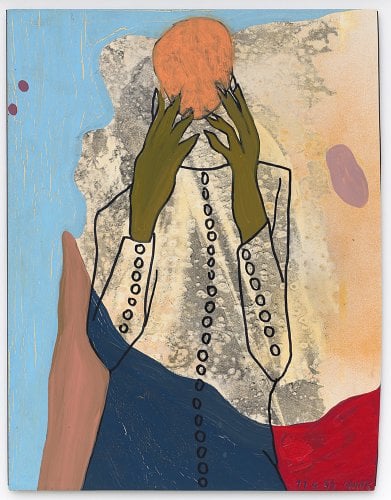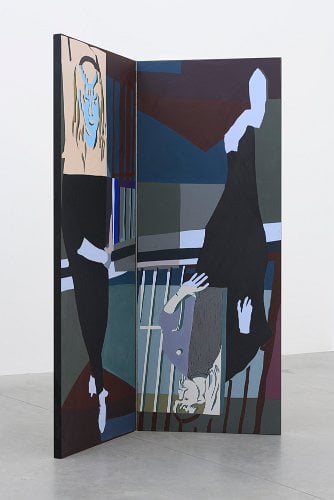Gallery Network
7 Questions for Belgian Artist Anne-Mie Van Kerckhoven, From Her Lifelong Fascination With Nudes to Her Own Alter Ego
Her show, “Placenta Saturnine Bercail,” at Zeno X Gallery marks the artist's 40th year showing with the gallery.

Her show, “Placenta Saturnine Bercail,” at Zeno X Gallery marks the artist's 40th year showing with the gallery.

Artnet Gallery Network

Forty years ago, Belgian artist Anne-Mie Van Kerckhoven (b. 1951) wandered into a new Antwerp gallery called Zeno X. By the time she had left, her first solo exhibition was on the books.
During the decades since, the artist has continued working with Zeno X, showing works that explore cliched depictions of female nudes and socio-political shifts related to changing technologies.

Anne-Mie Van Kerckhoven, Zwevend (Floating) (1999). Courtesy of Zeno X Gallery.
Now, to mark those four decades of collaboration, Zeno X Gallery is hosting the exhibition “Placenta Saturnine Bercail,” which brings together historical and new works by Van Kerckhoven that illustrate the arc of her career. A substantial publication overview of all her exhibitions in the gallery with images from the archive will be released to coincide with this exhibition.
Recently, we spoke with Van Kerckhoven about the exhibition, her database of images of women in various states of undress, and her art alter-ego.
Over the years you have built an extensive image database of women. How long have you been assembling this? And what drew you to images of undressed women in particular?
My image database includes more than 1,000 images of nude women, which I have been assembling since 1974. When I was a child I thought the essence of being an artist was drawing nude people. I learned a lot from the nude drawing classes during my studies in the Royal Academy in Antwerp and I didn’t want to stop this kind of exercise when I graduated. There wasn’t a possibility to draw nude people independently from being a student so I contented myself by drawing from the cheap second-hand nude magazines I found in thrift shops. I discovered the beauty, generosity, and self-assurance the photographed women from the ‘30s until the mid-’60s displayed. The reality of these images was in contradiction with the ruling feminist attitudes of that moment that looked at “sex workers” as victims. I was overwhelmed by the effect they had on me and spontaneously started to use the images as phenomena to confront and undermine a certain (male) discourse I loathed in culture and society at large.
Your works often incorporate bits of text. What do you see as the relationship between your work and text?
When the texts are in my work they serve as an additional aesthetic component, intrinsically necessary for the whole to work as a machine, to open into something new. The words counter the meaning of what is shown, the colors and materials used, as well as how the work is built up. You could say this is the contemporary form of manuscript illumination, where text adds to the message in the image.

Anne-Mie Van Kerckhoven, Resistir (to Resist) (1991). Courtesy of Zeno X Gallery.
What’s a typical day in the studio like for you?
Unless I have a very urgent deadline, all my days are different. I get up around 7:30 a.m., have coffee and bread, ritually read bits and pieces of specific books, and conjure up my lust for life. Usually I make a drawing in this special sketchbook I keep in my kitchen as a way of finding out where I’m standing that day. Then I go to my studio/library in the back of our house and work on my computer and anything that was not finished from the day before. Otherwise, I start something new or I write or I look for inspiration. Or I go to my big studio, one block up the road, and start working. Or tidy up. Or look in books I keep there for fun. I can’t bear the intensity in my big studio for longer than three hours at a time. Then I have to get out. And go back to my other studio again, working further on new work or my big archival book project. In between, I eat, of course, but not in my studio. Sometimes I go back to my big studio in the late afternoon and stay there until 6 or 7 p.m.
You have an artistic alter-ego called “HeadNurse.” Can you tell me about it?
My alter-ego HeadNurse is the opponent to the idea of “Big Brother.” She also is the assistant of Dr. Friederich Nietzsche. In 1995, I gave myself this new name as part of the project Elasticity at Home! The intention of the project was a long-standing socio-cultural quest starting from a list of 96 abstract terms I found in books on thermodynamics, knowledge representation, and the realities of space travel with images of women from my image database. In the mid-’70s, I met A.I.-expert Luc Steels, and I was allowed to work in his laboratory of artificial intelligence at the University of Brussels now and then, where I continued to develop this “Sex and Technology” project.
What is the role of your own image in your work?
When my own image appears in my work it is the recuperation of images of older selves, to look for new insights while using them, which often happens in moments of deep alienation.
You have been showing with Zeno X for 40 years. What interests have changed in your work over those years and what has stayed the same?
In the 40 years I’ve worked with Zeno X my interests haven’t changed that much, but they have widened under the influence of ideas and works of contemporaries or old sources discovered over time. My methods change depending on what I am working on at a specific moment. My work has become more direct. A lot of my older work had to pierce through a kind of wall of protection.
Out of my own frustration and inability to function in a world full of injustice and perversity, I have been fixated on matters such as woman’s powerlessness and the growing supremacy of technology. I am now confronted with the fact that the matters that kept me uneasy, fascinated, and busy for all these years, like sex and technology and their interconnection, have become some of the most important topics society has to deal with and solve.
Who are the artists and thinkers who most inspire you?
I have many: Jeroen Bosch, Bertold Brecht, Wittgenstein, Hildegard von Bingen, Sade, Galileo Galilei, Leibnitz, Kenneth Anger, Danny Devos, Goethe, Richard Rorty, Marguerite Porete, Sun Ra, Marguerite Yourcenar, David Lynch, Pharoah Sanders, Bunuel, Picasso, Mae West, Joan Didion, Charlotte Gainsbourg, Jean Cocteau, Paul Joostens, Pierre Huyghe, Hilma af Klint, Sofie Tauber Arp, Balthus, Pierre Klossowski, Evelyne Axell, Andy Warhol, David Lynch, Frans Zwartjes, Benny Claessens, the Dalai Lama, Camus, and many others.
“Placenta Saturnine Bercail” is on view at Zeno X Gallery through February 26, 2022.